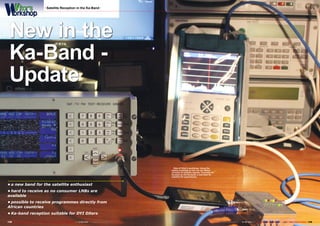The document discusses satellite reception in the Ka-band frequency range and provides an update on developments. It acknowledges mistakes made in a previous issue by showing incorrect satellite spectra. The text then provides the correct Ku-band and Ka-band spectra for various satellites and notes that only one consumer LNB is currently available for the Ka-band. It reports that some success has been achieved receiving signals from African providers via Eutelsat satellites, but that low symbol rates and scarce Ka-band LNBs present challenges. The Ka-band remains an interesting new area for satellite enthusiasts to explore.


